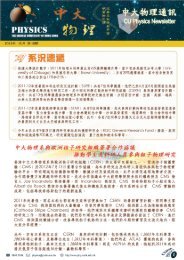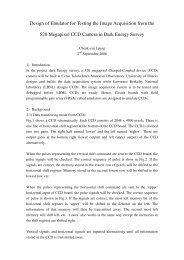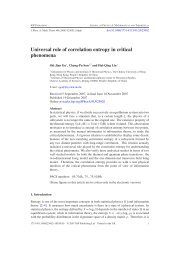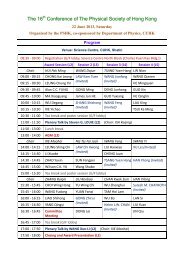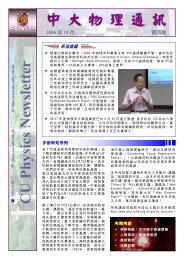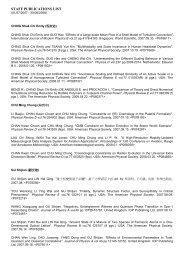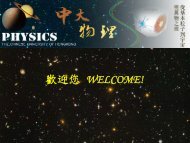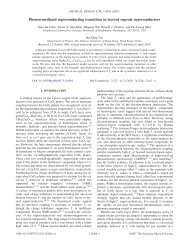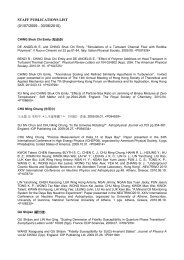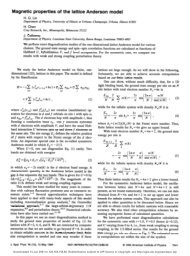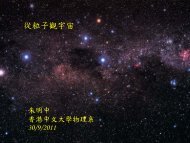Constructing soluble quantum spin models - Department of Physics ...
Constructing soluble quantum spin models - Department of Physics ...
Constructing soluble quantum spin models - Department of Physics ...
You also want an ePaper? Increase the reach of your titles
YUMPU automatically turns print PDFs into web optimized ePapers that Google loves.
H.Y. Shik et al. / Nuclear <strong>Physics</strong> B 666 [FS] (2003) 337–360 351<br />
eigenstate. Hence, the coefficients <strong>of</strong> those terms are set to zero, which is Eq. (43) as for the<br />
<strong>spin</strong>-1/2 case. If all conditions are satisfied, the eigenenergy <strong>of</strong> the completely dimerized<br />
state is −2J 1 × 2 × N where N = KLM is the total number <strong>of</strong> dimers. In the limit <strong>of</strong> large<br />
J 1 , the excitation gap is 2J 1 and it is from singlet to triplet.<br />
Among these twenty-two couplings, J 1 is independent <strong>of</strong> the others, four <strong>of</strong> them<br />
(J ‖ 7 ,J 10, J˜<br />
10 ,J ‖ 11<br />
) should be zero if there is no further neighbor couplings considered,<br />
and the rests seventeen couplings are connected by the seven conditions as stated in<br />
Eq. (43). Various combinations <strong>of</strong> them will lead to a variety <strong>of</strong> <strong>quantum</strong> phase transitions.<br />
Note that those seven conditions on couplings are not all related for some <strong>of</strong> them are<br />
independent <strong>of</strong> the others. In the followings, we discuss a few <strong>soluble</strong> cases. The objective<br />
is to obtain <strong>soluble</strong> <strong>models</strong> with minimum number <strong>of</strong> couplings. For all the cases, the<br />
condition 2J 2 = J 3 + J 4 is always held.<br />
5.1. Double layer model I: 2J 5 = J ‖ 3 + J ‖ 4<br />
This condition leads to another double layer model for there is no connections between<br />
layers, as shown in Fig. 4. In this model, the effect <strong>of</strong> J ‖ 3 and J ‖ 4<br />
on the dimers are exactly<br />
cancelled out by J 5 which is very similar to the net <strong>spin</strong> model we proposed before where<br />
the effects <strong>of</strong> J 2 are cancelled out by J 3 and J 4 .<br />
5.2. Double layer model II: J ‖ 6 = J 7<br />
Another double layer model can be constructed by the condition J ‖ 6 = J 7 (Fig. 5). The<br />
<strong>quantum</strong> fluctuation due to J ‖ 6 is cancelled out exactly by J 7, results in the completely<br />
dimerized state being an eigenstate.<br />
Fig. 4. The new double layer model constructed by conditions 2J 2 = J 3 + J 4 and 2J 5 = J ‖ 3 + J ‖ 4 .<br />
Fig. 5. The new double layer model constructed by conditions 2J 2 = J 3 + J 4 and J ‖ 6 = J 7.



